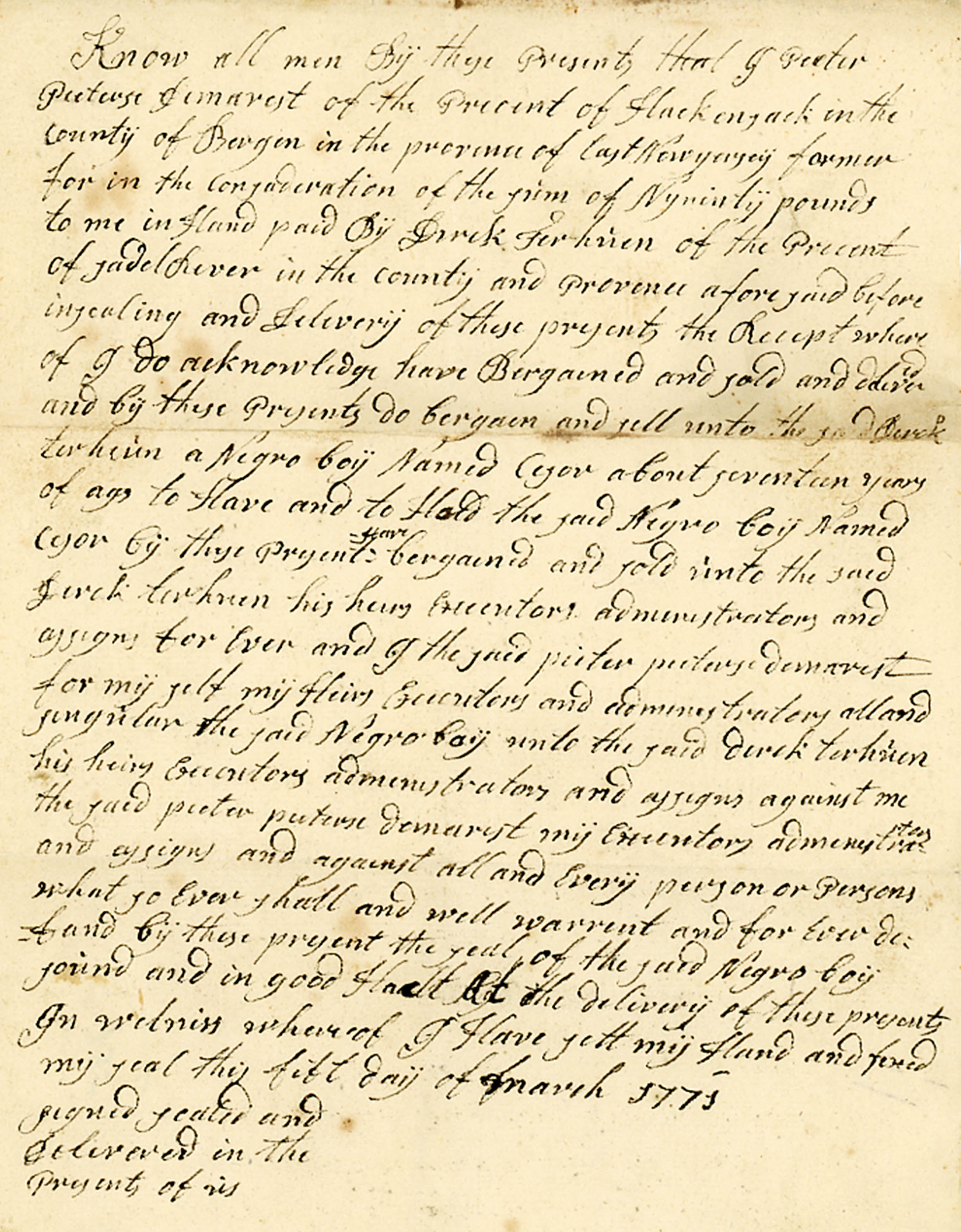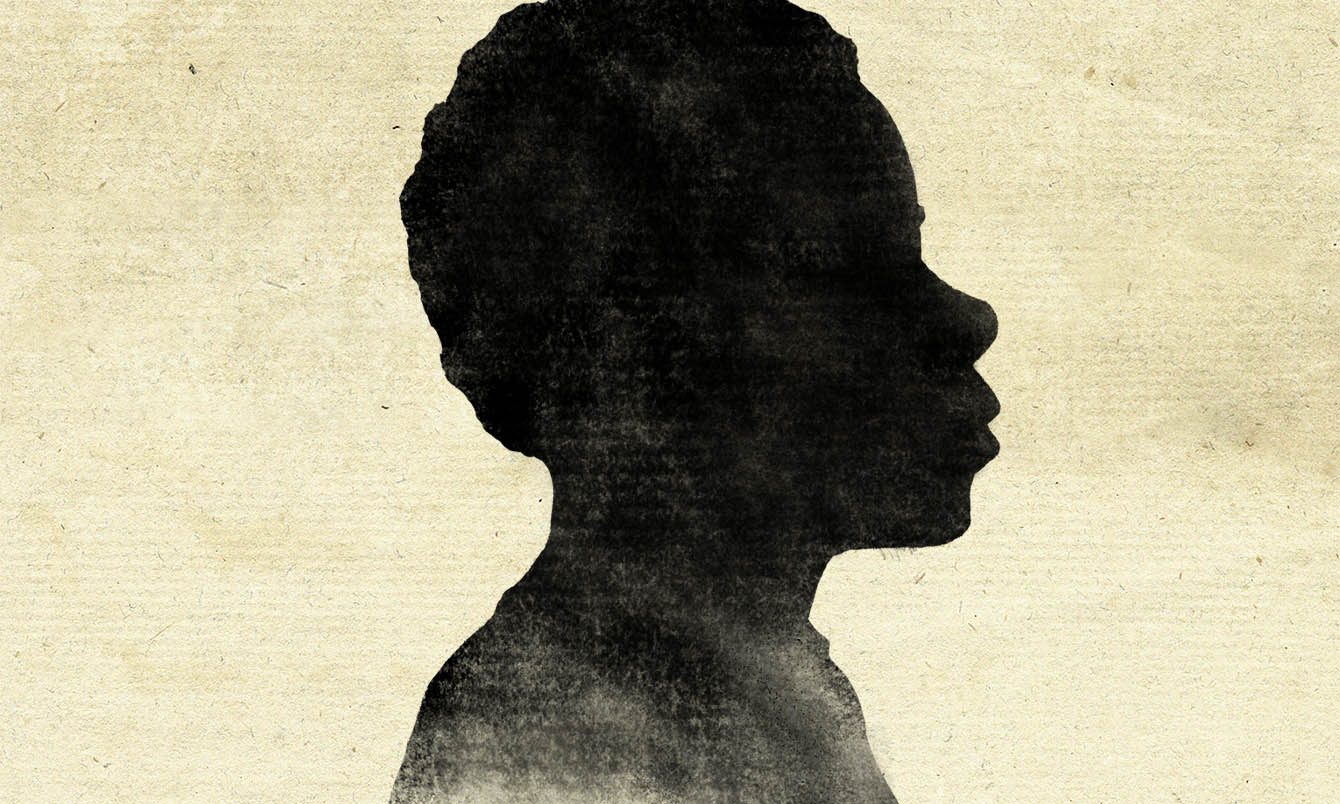A Bill of Sale
Explore this original historical document recording Peter Demarest’s 1771 sale of an enslaved 17-year-old man named Cesor to uncover the tragic impact of this commonplace practice.

Know all men
A bill of sale was a common legal document used to transfer the ownership of personal property. This one, handwritten by the seller and signed in the presence of witnesses, illustrates the status of enslaved individuals sold as property.

A Map of the country round Philadelphia including part of New Jersey, New York, Staten Island, & Long Island
1776
Unknown
This map shows the area of New Jersey where the sale of Cesor, a young enslaved man, took place.
Library of Congress, Geography and Map Division, Washington, D.C.
Peter Peterse Demarest of the precinct of Hackensack
The Demarests were a wealthy slaveholding family that owned land in many parts of Bergen County, New Jersey. Hackensack was the unofficial name of the township where Peter Demarest lived. The region was officially known as New Barbados because it supplied food provisions to Barbados, the Caribbean sugar island.
the sum of ninety ("Nyninty") pounds
Cesor was sold at a price that was twice the average salary for a tradesman. Some buyers would secure a mortgage to pay the purchase price. Enslaved individuals were often sold in exchange for debt, while others were given as gifts or to family members.
Dirck Terhuen
At 46, Dirck Terhuen had entered what in 1771 was considered late middle age, and may have needed additional help with farming and carrying goods to port.

Silhouette of a Young Man
A silhouette was one way a person's likeness was captured in the 18th century. Historic Hudson Valley has commissioned silhouettes to represent individuals of whom no other portrait is known to exist.
Cesor
As the only reference to Cesor known to exist, this bill of sale raises questions no one can answer. Was Cesor separated from his family on this date? Did he settle in Saddle River? Or was he sold again, given away, or bequeathed to Terhuen’s children?

Newburg
1820
William Guy Wall (American, born Ireland, 1792 - 1864)
In this detail of a rural Hudson Valley scene, a wagoner transports a load by cart. Enslaved individuals were involved with all types of work in the Hudson River Valley including transporting people and goods as coachmen, wagoners, boatmen and drovers.
Historic Hudson Valley.
seventeen years of age
In 1771 there were no laws restricting the age at which Cesor could be sold. Children as young as age seven were typically apprenticed to learn a trade. Ninety pounds was a substantial purchase price, suggesting that Cesor was valuable to the seller and the buyer because he was at the beginning of his most productive years as a laborer.
sound and in good Health
Although the buyer and seller were related through marriage, the note attesting to Cesor’s health suggested that the bill of sale was more than a formality. Cesor's high price made it important to have a legally binding document.
Bill of Sale Transcription
Know all men By these Present, that I Peter Peterse Demerest of the precinct of Hackensack in the County of Bergen in the province of East New Jersey former For in the consideration of the sum of Nyninty pounds to me in hand paid By Dirck Terhuen of the precinct of Sadel river in the county and province aforesaid before insealing and delivery of these present, the receipt where of I do acknowledge have Bargained and sold and deliver’d and by these present, do bargain and sell unto the said Dirck Terhuen a Negro boy named Cesor about seventeen years of age to Have and to Hold the said Negro boy named Cesor by these present have bargained and sold unto the said Dirck Terhuen by his heirs Executors administrators and assigns for Ever and I the said Peter Peterse Demarest for myself my Heirs Executors and administrators all and singular the said Negro boy unto the said Dirck Terhuen his heirs Executors administrator and assigns against me the said Peter Peterse Demarest my Executors administrators and assigns and against all and Every person or persons what so ever shall and well warrant and for ever defend by these present the seal of the said Negro boy sound and in good Health At the delivery of these present(.)
In witness whereof I Have sett my Hand and fixed my seal the fifth day of March 1771
signed sealed and Delivered in the present of viz.
Bill of sale
March 5, 1775
Peter Demarest (American, 1715-1780)
This business document reflects the status of a young man named Cesor as property that could be bought and sold.
Bergen County Historical Society.

Newburg
1820
William Guy Wall (American, born Ireland, 1792 - 1864)
In this detail of a rural Hudson Valley scene, a wagoner transports a load by cart. Enslaved individuals were involved with all types of work in the Hudson River Valley including transporting people and goods as coachmen, wagoners, boatmen and drovers.
Historic Hudson Valley.
seventeen years of age
In 1771 there were no laws restricting the age at which Cesor could be sold. Children as young as age seven were typically apprenticed to learn a trade. Ninety pounds was a substantial purchase price, suggesting that Cesor was valuable to the seller and the buyer because he was at the beginning of his most productive years as a laborer.
To continue please visit People Not Property on a larger screen or horizontal device to fully experience this feature.


